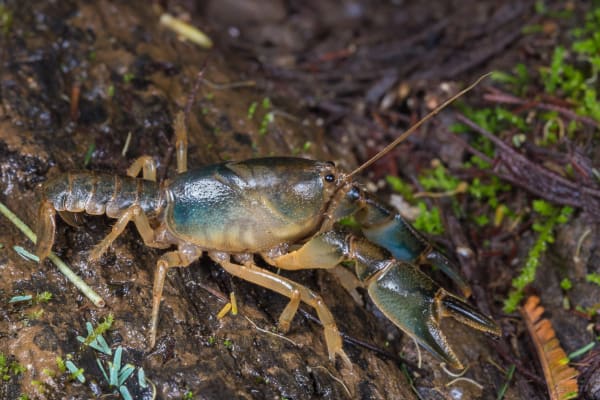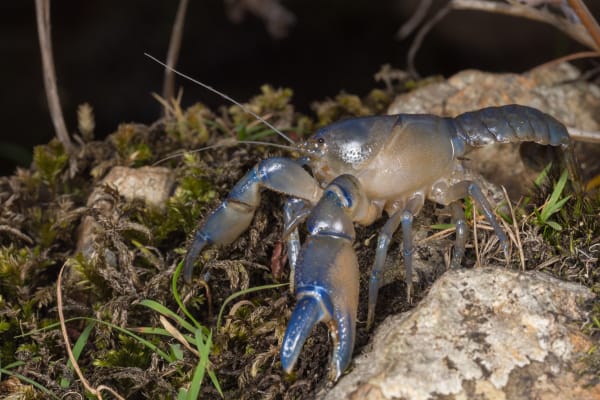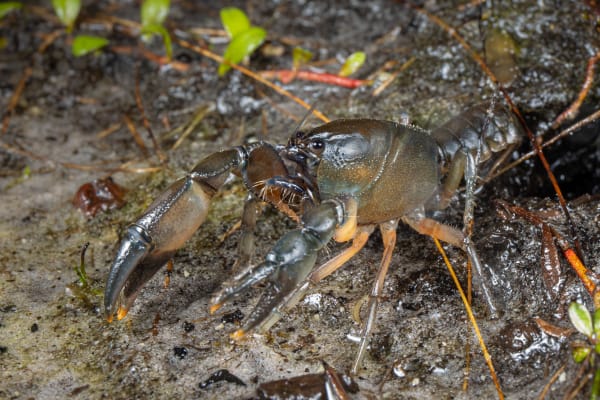It’s official: my great-grandchildren might be allowed to call themselves “Tasmanian”. A couple of years ago, we took the plunge and bought a property in the north-west. We are no longer annoying mainlanders who talk about “one day” moving to Tassie. We are annoying mainlanders who are.
It took us three years to find our little slice of heaven. And now we’ve bought, I miss the spontaneous weekends away to inspect properties. There’s a special excitement you feel each time you look at a new place, hoping “this will be the one”. There was also a bit of sport involved. It was always a laugh when we could make an estate agent tromp around these rural properties in inappropriate footwear. We came prepared in waterproof hiking boots so we could walk every inch of each property, ticking off the things we needed to see.
And being obsessed with freshwater crayfish, it was important to have a good close look at the river, rivulet, creek or dam. Invariably, we’d drive away chuckling while the estate agent was left scraping brown gunk (not always mud) off their lovely, but thoroughly inappropriate shoes.
And we owe an apology to all those estate agents – in the end, we bought privately.
Our place is almost seven hectares, half pasture and half bush. It backs onto a reserve and has a permanent creek, a big dam, a small wetland, and plenty of damp shady gullies. These gullies have springs at their heads and there is always a trickle of water threading its way downhill among the ferns.
Covid-19 travel restrictions have thwarted the survey to find out for certain whether we have giant freshwater lobsters in the creek and dam, but we do have burrowing crayfish.
In the gullies, there are the tell-tale “chimneys” these little critters make. As they burrow down towards the water table, they collect the damp soil they excavate, shape it into a small sticky ball and carry it to the surface, then push it out of the burrow. Depending on the depth of their hole, they may need to do this hundreds of times, and the castings pile up to form a striking, volcano-shaped chimney.
Although we haven’t seen them on the surface, I’m pretty certain we have the threatened Burnie burrowing crayfish (Engaeus yabbimunna). We’re in the right geographical location – an area of approximately 130 square kilometres stretching from Burnie to Wynyard and extending inland to Ridgley and Yolla. More than that, a survey in the reserve behind us identified them beside the headwaters of our creek.

I’ve sought advice from burrowing crayfish experts Alastair Richardson and Ryan Francis on how to observe these wonderful little creatures. Being a threatened species, you can’t just go and dig them up. But next time we get down to our place, I will carefully lift logs and rocks in the vicinity of the chimneys to see who might be hiding underneath – and carefully replace these items afterwards.
There are many species of burrowing crayfish and they are found across much of south-east Australia. In Tasmania, the north and the west coast are their heartlands. No specific Aboriginal name for any particular species, or burrowing crayfish generally, survived colonisation. But these animals were well-known to the early white settlers. As early as 1822, convicts at Macquarie Harbour would have seen burrowing crayfish, or “land crabs” as they were known, and their chimneys by the creeks that run into the Gordon River where they felled the ancient Huon pines. In Strahan, you can see plenty of chimneys next to the Hogarth Falls walking track, not far from the town centre.
When the Van Diemen’s Land Company’s surveyor Henry Hellyer first saw burrowing crayfish chimneys in 1826, while exploring near Port Sorell, the convicts in his party saw an opportunity to have a laugh at the expense of the “new chum” just off the boat from England. They convinced him these holes were made by snakes.
Two of the most common species in the north-west are Engaeus fossor and Engaeus cunicularius. I love these scientific names. “Fossor” alludes to its propensity for excavation, as fossor is an old term for a gravedigger. “Cunicularius” means rabbit in Latin, but I struggle to see the likeness – so it’s probably another allusion to burrowing. We can thank two Germans for these wonderfully kooky names.
E. fossor and E. cunicularius were first formally described in 1846 by Professor Wilhelm Erichson, the curator of invertebrates at the Museum für Naturkunde in Berlin. The specimens were collected in north-west Tasmania and sent to Erichson by his friend Adolphus Schayer, a sheep breeding expert (and avid collector of insects) who, like Henry Hellyer, was employed by the Van Diemen’s Land Company.
Schayer arrived in the colony in 1831, tasked by the VDL Company directors in London with improving the quality of the company’s flocks and dealing with the diseases that were killing their sheep in large numbers. Schayer immediately came into conflict with the company’s local Agent, Edward Curr, who had a reputation for being imperious, stubborn and argumentative. I imagine on arrival Schayer pointed out, with Teutonic directness, everything Curr was doing wrong. Curr responded by putting Schayer in charge of the company’s horses and cattle instead of the sheep. This insult was to last four years.
In 1835, Curr finally relented and appointed Schayer supervisor of the company’s flocks on their Woolnorth estate at Cape Grim. No doubt Schayer took great delight in outlasting Curr, who was dismissed by the company directors in 1841. Schayer stayed on for another two years serving the new agent, James Gibson, before a family crisis in Germany forced him to return home.
As well as burrowing crayfish, Schayer sent Erichson hundreds of insect specimens. In his 1842 paper describing the insects, Erichson thanked Schayer and rewarded him by naming the first new insect species he described, the saffron beetle, “Calosoma Schayeri” (NB although not current practice now, 19th century species names based on proper nouns were capitalised).


Schayer became unwittingly embroiled in a crayfish kerfuffle that lasted until very recently. As well as the E. fossor and E. cunicularius specimens, Schayer sent Erichson another small burrowing crayfish. Erichson named this one “Astacus Tasmanicus”. When the English naturalist Geoffrey Smith published a book and several research papers on his time in Tasmania in 1907-08, he promulgated the mistaken belief that this crayfish was a small variant of the stream-dwelling freshwater crayfish found around Hobart (Astacopsis franklinii). I guess Smith couldn’t read German (or didn’t have Google Translate), because Erichson’s description is very clear. “Herr Schayer machte mir darüber folgende Mittheilung: ‘Die aus Vandiemensland mitgebrachten Krebse leben unter der Erde’.” [“Mr Schayer gave me the following information: ‘The crustaceans brought from Van Diemen’s Land live underground’.”] Perhaps if Smith had lived longer, he might have corrected his mistake.
Smith died at the Battle of the Somme in France in July 1916. Captain Smith had just led his men in a successful attack on the German lines, capturing an enemy trench, when he was killed by a stray shell – probably an English one. His obituary, published in Nature and in the annual report of the Royal Society of Tasmania lamented, “thus a life of brilliant promise was extinguished in the early portion of its career”.
. . .
Because the specimen was held in Berlin, the mystery of what “Astacus Tasmanicus” really was, remained unsolved for the best part of another century. More confusion was added in the 1930s when Ellen Clark (Lobster Tale #2, Forty South, Issue 97) designated it, sight unseen, the sole member and “type species” of a new genus “Parastacoides”. She also incongruously suggested Schayer collected it near Mount Lyell. It is unlikely Schayer ever visited this region, which was inaccessible and unexplored in the 1840s. But without access to the original specimen, no one in Australia could sort out the mess.
Alastair Richardson, from the University of Tasmania, was determined to solve the conundrum and had the specimen sent to him in 1987. Richardson told me, “I knew it was Geocharax the moment I laid eyes on it.”

The 1990s saw the beginning of the widespread use of biochemistry and molecular genetics to separate closely related species, and several revisions of Tasmanian freshwater crayfish taxonomy followed. In 2006, Richardson and his PhD student, Brita Hansen, finally unravelled the mess and identified Schayer’s specimen as being Geocharax gracilis Clark, a burrowing crayfish Ellen Clark identified in southern Victoria, but it’s also found on King Island and in north-west Tasmania.
Richardson also explained to me that, in a quirk of scientific etiquette, because the species name “tasmanicus” was given to it by Erichson 90 years before Clark identified it on the mainland, it should be referred to as Geocharax tasmanicus Erichson. Ironically, the common name for Geocharax tasmanicus is the “Otways Cray”, in reference to it being found in the Otway Ranges in Victoria.
So, there we have it, this species of burrowing crayfish is just like me. It desperately wants to be Tasmanian, but it can’t shake its Victorian roots.
Terry Mulhern is a writer and academic. He has lived in Victoria for more than 20 years but, like a swift parrot, he migrates every summer across Bass Strait to north-west Tasmania.








